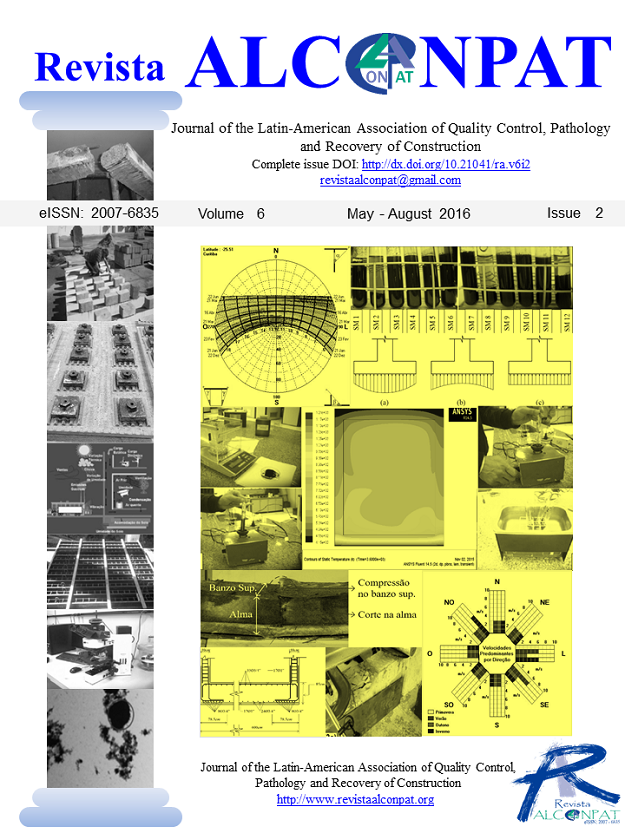Experimental analysis of various configurations of metal sheets in the reinforcement of flexion of reinforced concrete beams
Abstract
The external structural reinforcing steel, in the way of steel sheets attached with epoxy adhesive, is an option to increase the load capacity of reinforced concrete elements. This study evaluated concrete beams reinforced with steel sheets SAE 1020 of different thicknesses (0.75, 1.50, and 2.25 mm), longitudes (80 and 150 cm), and configurations (U-shape or flat) with the purpose of reviewing and comparing the best practices with sheets adhered to the structural reinforcement. Twenty-one beams were built with a cross-section of 12 x 20 cm and a longitude of 200 cm, with C25 concrete, and flexion frame with 2 Ø10 mm. The beams where subject to a four-point flexural test, which allowed analyzing the optimal loads and vertical displacements. Thus, a comparison relative to the performance of the beams is presented.
Keywords: structural reinforcement; cast steel plates; reinforced concrete beams
Downloads
References
Alfaiate, J., Costa, R. (2004), "O refuerzo de vigas de betão armado com chapas metálicas coladas com resina", Métodos Computacionais em Engenharia, APMTAC, Portugal. pp. 1-13.
Ali, M. S. M., Oehlers, D. J., Bradford, M. A. (2005) "Debonding of steel plates adhesively bonded to the compression faces of RC beams", Construction and Building Materials, V.19, No.6, pp. 413-422.
Associação Brasileira de Normas Técnicas (ABNT). NBR 5739: Concreto - ensaio de compressão de corpos de prova cilíndricos. Rio de Janeiro, 2007.
Associação Brasileira de Normas Técnicas (ABNT). NBR 6118: Projeto de estruturas de concreto. Rio de Janeiro, 2014.
Aykac, S., Kalkan, I., Aykac, B., Karahan, S., Kayar, S. (2013), “Strengthening and Repair of Reinforced Concrete Beams Using External Steel Plates”, Journal of Structural Engineering, V.139, No.6, pp. 929–939.
Campagnolo J. L; Campos Filho A., Silva Filho, L. C. P. (1994), "Técnicas de ancoragem em vigas de concreto armado reforzadas com chapas de acero coladas", In: 36a. REIBRAC - Reunión Anual do Instituto Brasileiro do Concreto, 1994, Porto Alegre/ RS.
Cánovas M. F. (1998), “Patologia e Terapia do Concreto Aramado”, São Paulo: Editora PINI, 522p.
Cánovas, M. F. (1985), "Refuerzo de elementos estructurales de hormigón armado mediante encolado de bandas de acero con adhesivos epoxídicos", Informes de la Construcción, V.37, No. 373, pp. 27-38.
Helene, P. R. L. (2000) "Manual para reparo, refuerzo e proteção de estruturas de concreto", 2 Ed, São Paulo: Editora PINI, 213 p.
Hussain, M. (1995), "Flexural behavior of pre-cracked reinforced concrete beams strengthened externally by steel plates", ACI Structural Journal, V.92, No. 1, pp. 14-23.
Jumaat, M. Z., Alam A. (2008), Experimental and analytical investigations on the structural behaviour of steel plate and CFRP laminate flexurally strengthened reinforced concrete beams", Journal of Applied Sciences, V.8, pp. 4383-4389.
Melo Júnior, L. O. (1997), "Comportamento ao cisalhamento de vigas em concreto armado reforzadas com chapas de acero coladas lateralmente", Mestrado em Engenharia Civil, Universidade Federal de Pernambuco (UFPE), Recife/PE, 81p.
Narayanamurthy, V., Chen, J. F., Narayanamurthy, J., Cairns, D.J., Oehlers, D.J. (2012) "Plate end debonding in the constant bending moment zone of plated beams", Composites Part B: Engineering, V.43, No. 8, pp. 3361-3373.
Oehlers, D., Moran, J. (1990), "Premature failure of externally plated reinforced concrete beams”, Journal of Structural Engineering, V.116, No. 4, pp. 978-995.
Patiño, A. L. (2005) "Comportamiento mecánico de vigas de hormigón armado reforzadas con bandas encoladas con resinas epoxi", Tesis Ingeniería Civil, Universidad Politécnica de Madrid (UPM), 323p.
Perelles, D. H., Medeiros, M. F., Garcez, M. R. (2013), "Aplicação da análise hierárquica como ferramenta de tomada de decisão para escolha do compósito de refuerzo com polímeros reforçados com fibras", Revista ALCONPAT, V.3, No. 3, pp. 165-180.
Santos, P. M. (2008), "Comparação de refuerzo com chapas de acero e fibras de carbono em vigas de concreto armado submetida à flexión simples", Trabalho de Final de Curso em Engenharia Civil, Universidade Estadual de Feira de Santana (UEFS), Feira de Santana/BA.
Silva Filho L. C. P., Helene P. R. L. (2011), "Análises de estruturas de concreto com problemas de resistência e fissuração", In.: Isaia G. C., Concreto: Ciência e Tecnologia. 1ª Edição. São Paulo: Editora IBRACON, V.2, Cap.32, pp. 1124-1174.
Simões, M. L. F. (2007), "Refuerzo à flexión de vigas de concreto armado por encamisamento parcial", Mestrado em Engenharia Civil, Universidade Federal do Rio de Janeiro (UFRJ), Rio de Janeiro/RJ, 162p.
Souza, V. C. M., Ripper, T. (1988), "Patologia, recuperação e refuerzo de estruturas de concreto", São Paulo: Editora PINI, 255 p.
Tisot, G. D. D. (2010), "Refuerzo à flexión de vigas de concreto armado submetidas a carregamento precoce", Trabalho de Conclusão de Curso em Engenharia Civil, Universidade de Passo Fundo (UPF), Passo Fundo/RS.
_______________________________
License in effect from September 2020
You are free to:
- Share — copy and redistribute the material in any medium or format for any purpose, even commercially.
- Adapt — remix, transform, and build upon the material for any purpose, even commercially.
- The licensor cannot revoke these freedoms as long as you follow the license terms.
Under the following terms:
- Attribution — You must give appropriate credit , provide a link to the license, and indicate if changes were made . You may do so in any reasonable manner, but not in any way that suggests the licensor endorses you or your use.
- No additional restrictions — You may not apply legal terms or technological measures that legally restrict others from doing anything the license permits.
Notices:
You do not have to comply with the license for elements of the material in the public domain or where your use is permitted by an applicable exception or limitation .
No warranties are given. The license may not give you all of the permissions necessary for your intended use. For example, other rights such as publicity, privacy, or moral rights may limit how you use the material.





















.png)














